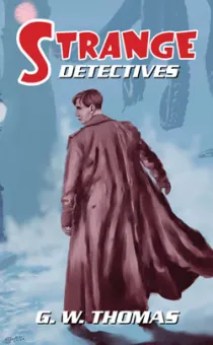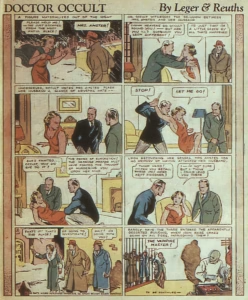
This post is brought to you by Strange Detectives by G. W. Thomas, featuring four cases by the Edwardian era detective, Richard Delamare. Along with his Watson, Bainbridge, Delamare investigates such strange happenings as severed hands that move on their own, ancient werewolf rites, sea ghosts and spirit photography. You also will meet the Victorian Dr. Drayk and the 1926 Athenodorians under the guidance of the Baron von Klarnstein. Creepy monster hunting in eras of the past. Perfect for Spooky Season!
By the 1930s, the occult detective had been around for around sixty years (if you measure from the appearance of Dr. Martin Hesselius) and probably longer. In the Pulps there were several famous ghost busters including Semi-Dual (started in 1912) and Jules de Grandin (started 1925). The average comic strip reader did not need a lengthy explanation what such a character might be. The idea of a man or woman who understood about ghosts and the occult who could help those in need was new only to the comic strips. The true comic book would be born in this decade as well with the coming of Superman in 1938.
During the 1930s, there were three examples of comic strip characters that fought the forces of evil all the time or sometimes only occasionally. Villains could prove real monsters or more often the false variety. You often, in Flaxman Low style, had to wait and find out. No matter the Scooby-Doo reveal, the hunt for the killer/monster was filled with Gothic touches like haunted houses, rattling chains and moon-lit nights.


Lee Falk was creator of Mandrake the Magician, a character many critics feel was the first superhero. Certainly he solved earthly crimes with his stage magician panache but there were others where he faced off against real creatures of darkness. His first supernatural story was “The Monster of Tanov Pass” (Mandrake the Magician, February 25-June 15, 1935) followed by “The Werewolf”. Mandrake’s adventures would get wilder and wilder, eventually including a lost world of dinosaurs, a Flying Saucer invasion, a trip to the Moon and a cloud city. There is only so much a crime-solving a magician can do.


Dr. Richard Occult (New Fun Comics #6, October 1935)/Dr. Mystic (Comic Magazine #1, 1936) was the first professional ghost chaser. He was created by Jerry Siegel and Joel Shuster, the guys who gave us Superman a few years later, under their Leger & Reuths pseudonyms. The good doctor had a bit of name change at the start, creating two different versions for two different venues. The boys blended the two eventually, going with the Occult name. The real innovation here was that Dr. Occult was a true supernatural character, the first of a long line of characters named “Doctor Something”, of which Doctor Strange was a late-comer. The werewolves and vampires of “Dr. Occult” were not the usual run of Dick Tracy style villains that had weird names but were human enough. For more on the Dr. Occult story, go here.


The Disney trio of Mickey Mouse, Goofy and Donald Duck as ghostchasers started with “The Seven Ghosts”, August 10-November 28, 1936 written by Ted Osborne. All three characters had other stories without any ghosts at all but they famously did chase ghosts in both comic strip and cartoon. This comic strip story-line provided the material for the cartoon “Lonesome Ghosts” (1937). It was the first of many Disney comic strips and comics that involved famous cartoon characters exploring the netherworld of ghosts, which might be real or not.



“Lonesome Ghosts” begins with Mickey, Donald and Goofy snoozing at their ghostbreaking business. The phone rings when a bunch of mischievous ghosts call them to their haunted house. Gags ensue, of course, but they end with the trio getting covered in molasses and flour and looking like ghosts themselves. The real ghosts get spooked by the fake ones. The three don’t get any money for this three minute romp but it doesn’t matter. Ghost Buster tropes are fun. Watch “Lonesome Ghosts” here.
Conclusion

 These three occult detectives may seem less exciting compared to the great characters of later decades like Doctor Strange or John Constantine but without this initial 1930s success nothing would have followed. 1940 would see an explosion of Mandrake-like snoopers just as the same comics would produce buckets of Tarzan and Buck Rogers/Flash Gordon clones. Before this flood, it was stars like Dr. Occult who transitioned readers from the Pulp masters of Jules de Grandin fame to new three panel then later comic book characters. Readers enjoyed a good creepy Gothic ghost hunt in any medium as Bob Hope and Paulette Goddard would prove the following year in The Ghost Breakers. The occult detective was about to become one of the icons of storytelling in comics, Pulps, on Radio and the silver screen.
These three occult detectives may seem less exciting compared to the great characters of later decades like Doctor Strange or John Constantine but without this initial 1930s success nothing would have followed. 1940 would see an explosion of Mandrake-like snoopers just as the same comics would produce buckets of Tarzan and Buck Rogers/Flash Gordon clones. Before this flood, it was stars like Dr. Occult who transitioned readers from the Pulp masters of Jules de Grandin fame to new three panel then later comic book characters. Readers enjoyed a good creepy Gothic ghost hunt in any medium as Bob Hope and Paulette Goddard would prove the following year in The Ghost Breakers. The occult detective was about to become one of the icons of storytelling in comics, Pulps, on Radio and the silver screen.
Next time…1940. Get ready to explode!
Mythos Horror & Ghostbreakers at RAGE m a c h i n e





Loved the post. Very interesting.